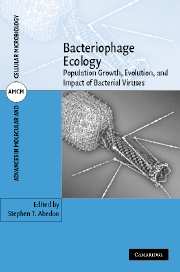Book contents
- Frontmatter
- Contents
- About the cover
- List of contributors
- Foreword by Bruce R. Levin
- Preface
- 1 Phages, ecology, evolution
- Part I Phage ecology
- 2 Bacteriophages: models for exploring basic principles of ecology
- 3 Phage population growth: constraints, games, adaptation
- 4 Impact of spatial structure on phage population growth
- 5 Contribution of lysogeny, pseudolysogeny, and starvation to phage ecology
- Part II Phage evolutionary biology
- Part III Phage ecology in environments
- Part IV Modeling phage ecology
- Index
- Plate section
3 - Phage population growth: constraints, games, adaptation
from Part I - Phage ecology
Published online by Cambridge University Press: 29 September 2009
- Frontmatter
- Contents
- About the cover
- List of contributors
- Foreword by Bruce R. Levin
- Preface
- 1 Phages, ecology, evolution
- Part I Phage ecology
- 2 Bacteriophages: models for exploring basic principles of ecology
- 3 Phage population growth: constraints, games, adaptation
- 4 Impact of spatial structure on phage population growth
- 5 Contribution of lysogeny, pseudolysogeny, and starvation to phage ecology
- Part II Phage evolutionary biology
- Part III Phage ecology in environments
- Part IV Modeling phage ecology
- Index
- Plate section
Summary
INTRODUCTION
Pick up an introductory biology textbook that describes bacteriophages. The presented phage life cycle, often using phage λ as an example, will typically be differentiated into two distinguishable types: the lytic cycle and the lysogenic cycle. This differentiation is real but overly simplistic. First, both the lytic cycle and the lysogenic cycle differ among different phages by numerous molecular details (Calendar and Abedon, 2006). Second, and as typically mentioned, not all phages display a lysogenic cycle (Chapter 5). Third, though atypically mentioned, not all phages display a lytic cycle (Russel and Model, 2006), at least in the sense of productive phage infection followed by a phage-induced bacterial lysis. In this chapter I provide an overview of the ecology of the virion-mediated population growth displayed by obligately lytic phages (sensu Chapter 1, Section 1.2.2.5). That is, I explore the ecology of phage adsorption and infection of susceptible bacteria, virion maturation within those bacteria, and then lytic release of phage progeny. I take an evolutionary ecological perspective, considering the impact of phage adaptations on phage population growth (as also does Chapter 2).
Productive phage infection
As described in greater detail in Chapter 1, phage infections may be differentiated into productive versus non-productive (the latter including lysogeny; Chapter 5), with production referring to the intracellular maturation and then release of phage virion particles.
- Type
- Chapter
- Information
- Bacteriophage EcologyPopulation Growth, Evolution, and Impact of Bacterial Viruses, pp. 64 - 93Publisher: Cambridge University PressPrint publication year: 2008
- 12
- Cited by



